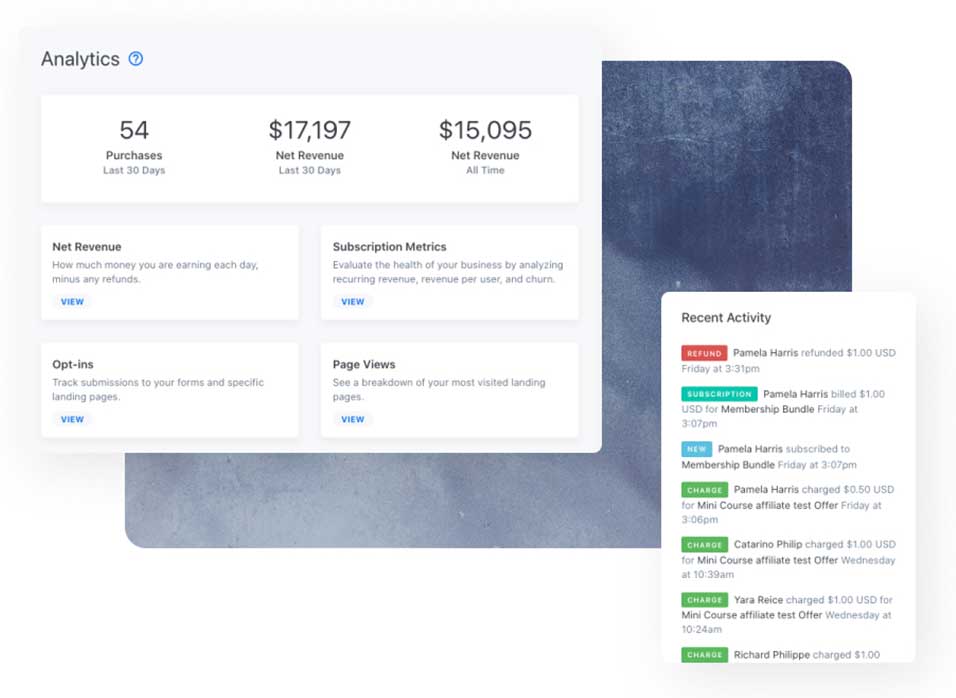![]()
Kajabi Versus Zapier: Which is Better?
In today’s fast-paced digital world, businesses and entrepreneurs find themselves in constant need of efficient and user-friendly online platforms to help manage their operations.
In an ocean of available options, two platforms have risen to prominence: Kajabi and Zapier.
As a considerable number of individuals and organizations explore these platforms, understanding their capabilities, features, and differences becomes paramount. In the following article, we will dive into the world of Kajabi and Zapier, comparing their unique offerings, dissecting their strengths and weaknesses, and ultimately determining which platform will best suit your business needs.
|
Featured Partner 
on Kajabi’s website
|
Join us as we delve into a comprehensive comparison of Kajabi versus Zapier, heralding a new understanding of their roles in revolutionizing the way businesses operate in the digital age.
What is Kajabi
Kajabi is an all-in-one platform designed for entrepreneurs, content creators, and small businesses to create, market, and sell online courses, membership sites, and other digital products.
![]()
It offers customizable website templates, email marketing tools, and various integrations to help users build their online business. The platform aims to simplify the process of creating and monetizing content by providing various tools and features in one place.
What is Zapier
Zapier is a web-based automation platform that allows users to connect and integrate various applications to automate repetitive tasks.
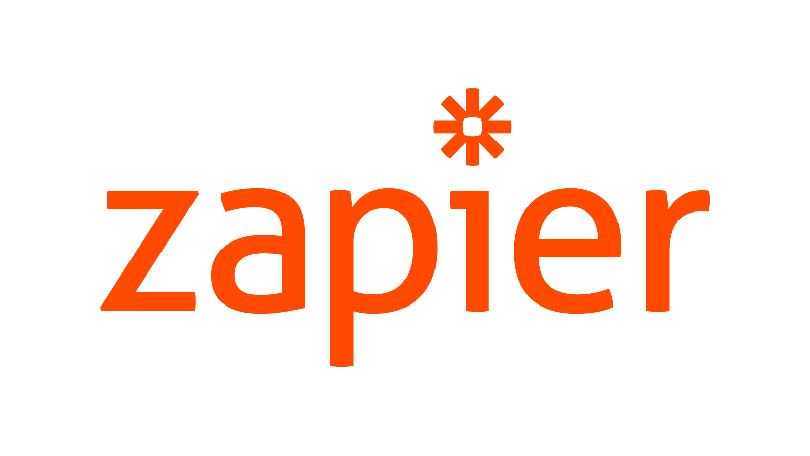
By creating workflows, called “Zaps,” users can streamline processes and improve productivity. It supports a wide range of apps, including popular ones like Gmail, Slack, and Trello.
|
Featured Partner 
on Kajabi’s website
|
Why Use?
Kajabi is an all-in-one platform for creating, marketing, and selling online courses and digital products.
Zapier, on the other hand, is a tool that helps integrate and automate tasks between different web apps.
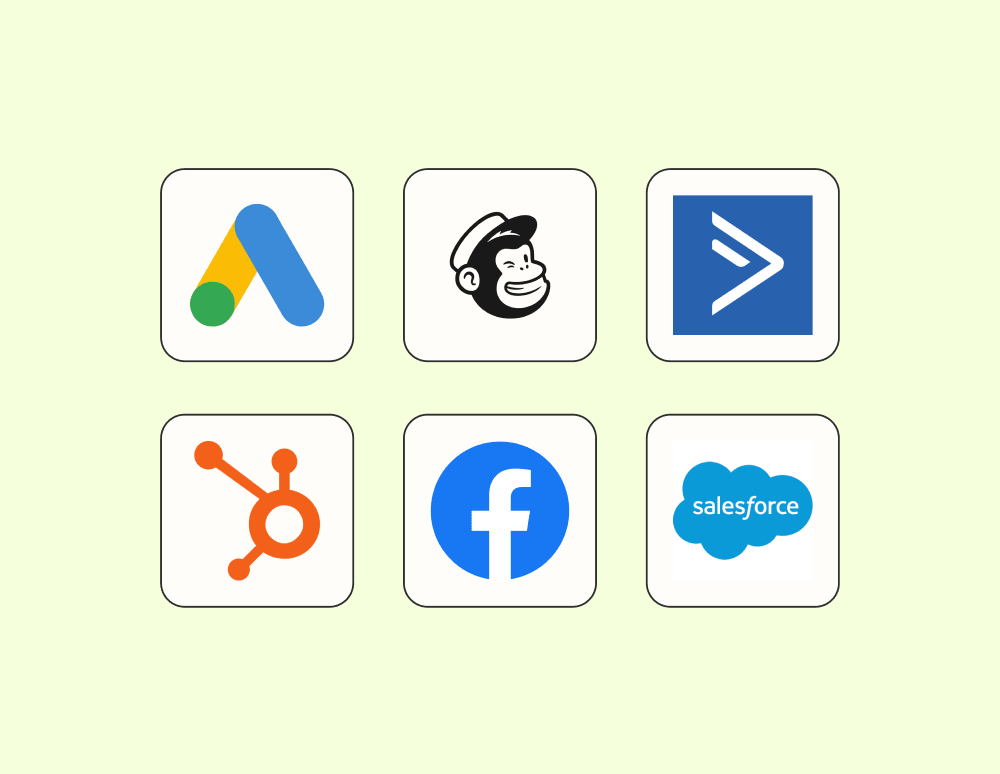
Together, they can streamline workflows by connecting Kajabi with other applications. Here are some example use-cases for Kajabi and Zapier integration:
1. Automate lead generation: When a user signs up for a Kajabi course or opts into an email list, you can use Zapier to automatically add their contact information to a CRM like Salesforce or HubSpot. This improves lead management and helps your sales team keep track of potential customers.
2. Streamline customer support: Kajabi users often need support, and you can ensure timely assistance by connecting Kajabi to a helpdesk app like Zendesk or Freshdesk. For instance, whenever a user submits a query through Kajabi, Zapier can automatically create a ticket in your helpdesk app, allowing your support team to respond more efficiently.
3. Automatic email campaigns: Use Zapier to connect Kajabi with your email marketing platform such as Mailchimp or ConvertKit. This way, whenever a user enrolls in a Kajabi course or signs up for a mailing list, they automatically receive a series of welcome and nurture emails that engage them throughout their learning experience.
4. Simplifying event registration: If you host webinars or events related to your Kajabi courses, you can use Zapier to integrate Kajabi with an event registration app like Eventbrite or GoToWebinar. When someone enrolls in a course, Zapier can automatically register them for the relevant event and send them the necessary information.
5. Social media marketing: You can utilize Zapier to automatically share updates about your Kajabi courses on social media platforms like Twitter and Facebook. For example, when you publish a new course, create a Zap that triggers a social media post, helping you instantly promote your new content without manually crafting and publishing the post.
6. Manage affiliates: If your Kajabi courses have an affiliate program, Zapier can help you integrate it with affiliate management apps like ReferralCandy or Post Affiliate Pro. When affiliates generate sales, Zapier can automatically track the sales and ensure affiliates receive their commission on time.
7. Collect and analyze customer feedback: Connect Kajabi and survey platforms like SurveyMonkey or Typeform to easily gather user feedback on your courses. You could set up a Zap to automatically send survey links to users after they complete the course, helping you understand their experience and make improvements accordingly.
|
Featured Partner 
on Kajabi’s website
|
Features
Kajabi:
Kajabi is a comprehensive and user-friendly platform designed to simplify the process of creating, marketing, and selling online courses and memberships.
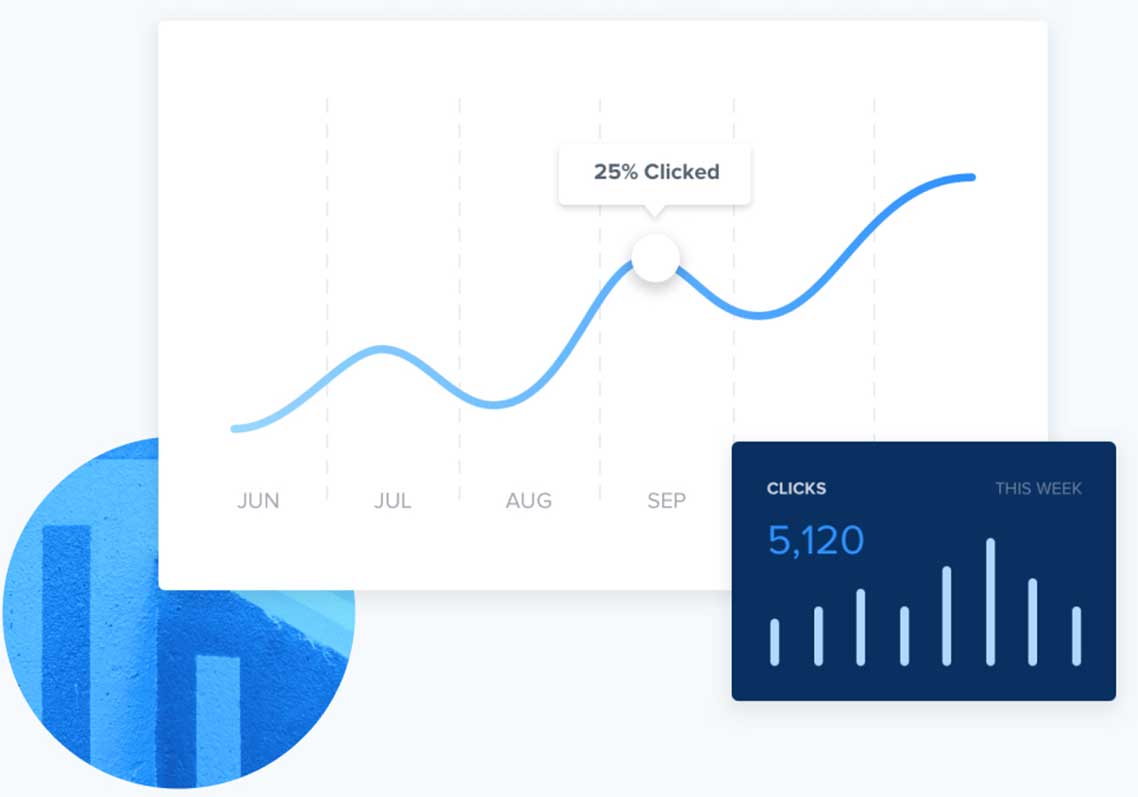
Its outstanding features can be categorized into four main areas: course creation, marketing and sales, automation and engagement, and analytics and reporting.
1. Course Creation:
- Kajabi enables users to seamlessly create and organize content with its powerful site builder and intuitive course builder. The platform offers multiple customizable themes and templates, ensuring users can design and construct aesthetically-pleasing and functional online courses without needing technical expertise.
- Additionally, Kajabi supports various content formats, including videos, audios, and documents, allowing for an engaging learning experience.
2. Marketing and Sales:
- Kajabi’s integrated marketing and sales tools help users effectively promote their offerings and boost sales. The platform features email marketing tools, pipelines (sales funnel builder), landing pages, and customizable checkout pages.
- Furthermore, Kajabi enables integration with popular payment gateways like Stripe and PayPal, ensuring a smooth and secure transaction process.
3. Automation and Engagement:
- To maximize productivity and user engagement, Kajabi offers automation tools such as automated email sequences, tagging, and event-based triggers. This allows users to automate repetitive tasks and focus on growing their online business, while also offering quizzes, surveys, and assessments to gauge members’ progress and ensure a high level of engagement.
4. Analytics and Reporting:
- Kajabi provides robust analytics and reporting features to help users track performance and gain insights into their online business. The platform generates in-depth reports on student progress, revenue, engagement metrics, web analytics, and more. This valuable data aids in making informed decisions for future growth and improvement.
Zapier:
Zapier is a renowned automation platform that specializes in connecting and integrating various web applications, enabling users to automate repetitive tasks and streamline workflows.
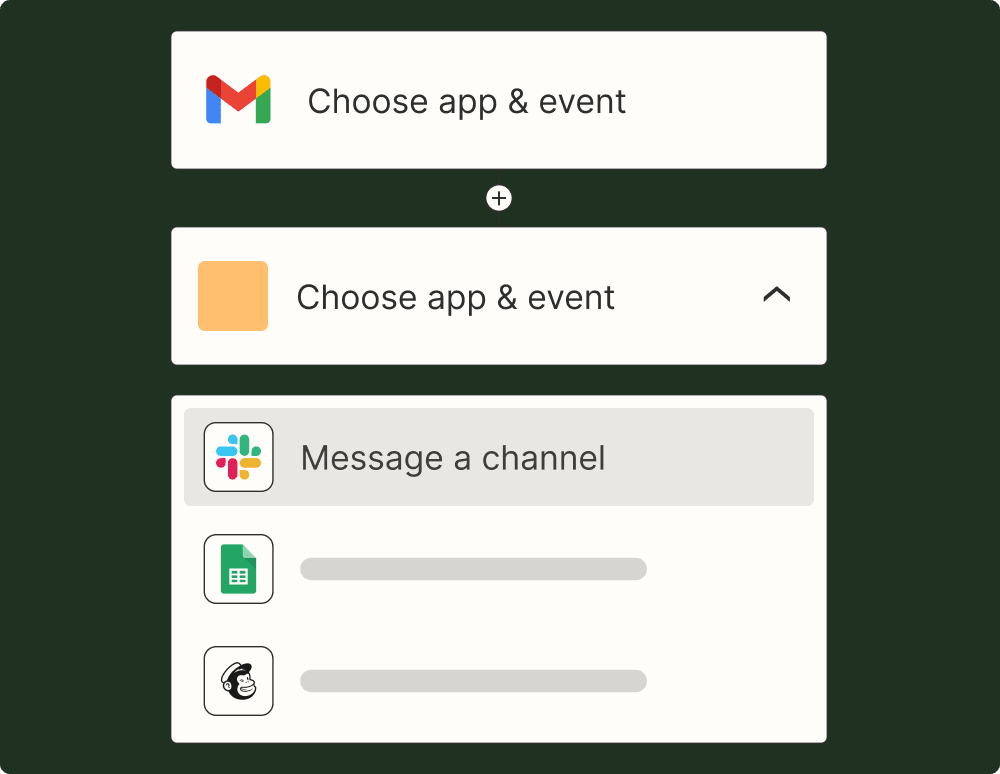
Its primary features can be grouped into three main areas: app integration, automation, and ease of use.
1. App Integration:
- Zapier boasts a vast library of over 3,000 supported apps, including popular platforms like Google Sheets, Slack, Trello, and Mailchimp. This extensive integration capacity allows users to connect multiple apps, synchronize data, and streamline their digital workflows with increased efficiency.
2. Automation:
- Zapier’s core functionality lies in its automation capabilities, offering “Zaps” (automated workflows) that enable users to automate tasks between apps. For example, a Zap can be set up to automatically add new email subscribers to a Google Sheet or update a Trello card once a specific task is completed in another tool. Users can create custom Zaps or choose from pre-built templates, further simplifying the automation process.
3. Ease of Use:
- Zapier’s intuitive user interface and straightforward setup process make automation accessible to users with varying technical expertise. The platform requires no coding, allowing users to quickly build, customize, and deploy Zaps without the need for technical support.
- Additionally, Zapier offers excellent customer support, numerous tutorials, and an active community forum, ensuring users have ample resources to navigate potential challenges.
In summary, Kajabi is a comprehensive platform designed to facilitate effective creation, marketing, and selling of online courses and memberships.
In contrast, Zapier focuses on automating tasks between web applications, allowing users to streamline workflows and optimize productivity. Both platforms offer unique benefits that cater to different user needs and objectives.
|
Featured Partner 
on Kajabi’s website
|
Pros n Cons
Kajabi Pros:
1. All-in-one platform:
- Kajabi is an integrated online course platform that handles everything from content creation, hosting, website design, payment processing, marketing and analytics.
2. User-friendly interface:
- Kajabi offers an intuitive interface, making it easy for users of all skill levels to create and manage their courses.
3. Customizable themes:
- Kajabi offers a variety of themes and templates that can be easily customized to match your brand and business needs.
4. Integrations:
- Kajabi integrates with many popular third-party tools, such as Mailchimp and ConvertKit, which can further streamline your marketing and email campaigns.
5. Community and support:
- Kajabi offers a strong community and excellent customer support to help users troubleshoot issues and optimize their courses.
Kajabi Cons:
1. Cost:
- Kajabi is relatively expensive compared to other online course platforms, which can make it inaccessible for some users, especially those with limited budgets.
2. Limited flexibility:
- While Kajabi offers a variety of templates, it may not be as customizable or open to third-party plugins as other platforms like WordPress.
3. Learning curve:
- Some aspects of Kajabi, such as the email marketing and automation tools, can have a steep learning curve for beginners.
Zapier Pros:
1. Workflow automation:
- Zapier enables users to automate various tasks and workflows by integrating with multiple apps and services, saving time and increasing productivity.
2. Easy-to-use interface:
- Even with minimal technical knowledge, users can easily create and manage their workflows (or “Zaps”) using Zapier’s intuitive interface.
3. Wide selection of apps:
- With over 3,000 apps available, Zapier offers a wide range of integration options, catering to different needs and industries.
4. Customizable workflows:
- Users have the ability to combine different triggers, actions, and filters to create unique, automated workflows tailored to their specific requirements.
Zapier Cons:
1. Cost:
- While there is a free tier for basic functionality, Zapier can become pricey for advanced features, high task volumes, or multiple user accounts.
2. Limited features on lower-tier plans:
- Some features, such as task history and multi-step Zaps, are only available on higher-tier plans.
3. Delayed data syncing:
- Due to the nature of third-party integrations, delays can occasionally occur in data syncing between apps and services.
4. No native app for mobile devices:
- Zapier does not have a dedicated mobile app, which may limit functionality and convenience for users who frequently work on the go.
How to setup Kajabi
Step 1: Sign up for a Kajabi account
- Visit Kajab’s website at https://www.kajabi.com/.
- Click on the “Get Started” or “Start Free Trial” button.
- Fill out the required information, including your name, email address, and password.
- Click “Create your Kajabi account” to complete the registration process.
Step 2: Choose a plan
- Review Kajabi’s pricing options to determine which plan best suits your needs.
- Select a plan, which can be changed at any time, by clicking on the “Choose Plan” button below your preferred option.
- Fill out your payment details to activate the plan.
Step 3: Customize your site
- Log in to your Kajabi dashboard.
- Click “Website” in the left-hand menu and then “Design Your Site.”
- Choose a theme for your site and adjust colors, fonts, and other visual elements to match your brand.
- Create and customize pages (such as Home, About, Contact, etc.) by clicking “Pages” in the left-hand menu, and then “Add New Page.”
Step 4: Create online courses or products
- Click “Products” in the left-hand menu of your dashboard.
- Click “Create a new product” and choose a product template (such as mini-course, online course, or community).
- Provide a name and description for your product and click on “Create a Product.”
- Customize your product’s content by adding sections, lectures, and other materials.
- Configure your product’s settings, including pricing, access rules, and integrations with other tools.
Step 5: Set up payment and marketing options
- Click “Settings” in the left-hand menu and then “Payments” to connect Kajabi to your preferred payment gateway (e.g., Stripe, PayPal).
- Customize your checkout settings, such as currency, taxes, and legal agreements.
- Set up email marketing, if desired, by clicking “Email” in the left-hand menu and connecting Kajabi to an email service provider such as Mailchimp or ActiveCampaign.
- Create and customize marketing funnels, also known as pipelines, to automate your sales process by clicking “Pipelines” in the left-hand menu and then “Create New Pipeline.”
After completing the steps above, your Kajabi site will be ready to launch. Share the link to your site with your audience, promote your courses, and watch your online business grow!
|
Featured Partner 
on Kajabi’s website
|
How to setup Zapier
Zapier is an online automation tool that allows you to connect and automate tasks between different web applications. It is designed to make it easy for non-technical users to create automated workflows, called “Zaps,” between apps.
Setting up Zapier involves creating an account, connecting apps, and setting up Zaps.
Step 1: Create a Zapier account
- Visit the Zapier website at https://zapier.com/.
- Click on the “Get Started for Free” or “Sign Up” button from the homepage.
- You can either sign up using your Google account or provide your name, email, and a password to create a new account.
- After registering, you will receive an email confirmation. Click on the link provided in the email to activate your account.
Step 2: Connect your apps
In order to use Zapier, you need to connect the web applications that you want to automate. The following steps explain how to connect your apps:
- Log in to your Zapier account.
- Click on “Connected Accounts” in the left sidebar menu.
- In the “Search apps” field, search for the app you’d like to connect.
- Select the app from the search results, and a new window will open asking for permission to access the app.
- Sign in to the app and grant Zapier the necessary permissions to access your account.**
Step 3: Set up your first Zap
Once you’ve connected your apps, you can create a new Zap that automates tasks between them.
- After logging into your Zapier account, click on the “Make a Zap” button at the top of the screen.
- In the “Choose App & Event” section, search for your desired trigger app (the app that will initiate the automation).
- Choose the specific “trigger event” that you want to use, then click “Continue.”
- Select the connected account for the trigger app, and click “Continue.”
- Customize your trigger by defining any additional options (if necessary) and testing the trigger to ensure it works correctly.
- Once the trigger is set, you’ll be prompted to set up an action app (the app that will perform a task based on the trigger).
- Choose the action app from the list, and select an “action event” to perform.
- Click “Continue” and select the connected account for the action app.
- Customize your action by defining any additional options and testing the action to ensure it works correctly.
- After setting up both the trigger and action, click on “Turn on Zap” to activate your new automation.Congratulations! You’ve now successfully set up Zapier and created your first Zap. You can continue adding and customizing Zaps to automate your daily tasks and improve efficiency.
|
Featured Partner 
on Kajabi’s website
|
Main Differences

Kajabi and Zapier are two distinct platforms that serve different purposes, but they can also complement each other to create a powerful and seamless workflow.
Kajabi is an all-in-one platform designed primarily for knowledge entrepreneurs to create, market, and sell online courses, memberships, and digital products. It offers a range of tools and features, including website building, email marketing, and sales funnel creation, that streamline the process of running an online business.
On the other hand, Zapier is a platform that specializes in connecting and automating tasks between various web applications, helping users save time and effort in managing multiple tasks and services.
While Kajabi is specifically tailored for entrepreneurs in the online education and digital product space, Zapier supports a broader spectrum of use cases and industries. Zapier enables users to connect and automate tasks between a vast array of web-based services, such as Gmail, Slack, Trello, Google Sheets, and many more, by providing a simple interface to create customized workflows called “zaps”. These zaps essentially help users easily transfer data and automate tasks without the need for additional programming or technical skills. In contrast, Kajabi’s comprehensive ecosystem is focused on providing tools and features that are directly relevant and useful for content creators and knowledge entrepreneurs.
Despite their differences, Kajabi and Zapier can work together to bring additional functionality and automation to Kajabi users. By utilizing Zapier’s integration capabilities, Kajabi users can connect their platform with other web services to automate tasks and enhance their online business productivity. For example, a Kajabi user could create a zap to automatically add new course enrollees to a separate email marketing tool like Mailchimp or send a notification to a dedicated Slack channel when a new purchase is made.
In this way, Kajabi and Zapier complement each other, with Kajabi focusing on delivering a comprehensive solution for creating and selling digital products, while Zapier empowers users to create additional custom workflows and connect with various external tools.
Pricing Comparison
Kajabi and Zapier are two different platforms that serve different purposes, which makes it difficult to compare their pricing directly. However, I can provide you with the pricing information for both platforms.
Kajabi’s Pricing Plans:
- Basic Plan:
- $149 per month (billed annually) or $199 per month (billed monthly)
- 3 products and 3 pipelines
- 1,000 active members
- 1 website and 1 admin user
- 0% transaction fees
- Unlimited landing pages and marketing emails
- Webinars and events, chat support, and more
- Growth Plan:
- $199 per month (billed annually) or $299 per month (billed monthly)
- 15 products and 15 pipelines
- 10,000 active members
- 1 website and up to 10 admin users
- 0% transaction fees
- Unlimited landing pages and marketing emails
- Advanced features like 24/7 chat support, automated webinars, and more
- Pro Plan
- $399 per month (billed annually) or $499 per month (billed monthly)
- 100 products and 100 pipelines
- 20,000 active members
- 1 website and up to 25 admin users
- 0% transaction fees
- Unlimited landing pages and marketing emails
- Premium features like 24/7 phone support, affiliate program, and more
Zapier, on the other hand, is an online automation tool that allows you to connect different apps and automate workflows.
|
Featured Partner 
on Kajabi’s website
|
Zapier Pricing Plans
- Free Plan:
- $0 per month. This plan allows you to create 5 Zaps (automated workflows) and perform 100 tasks per month.
- Starter Plan:
- $19.99 per month (billed annually) or $24.99 per month (billed monthly).
- This plan allows you to create 20 Zaps and perform 750 tasks per month, along with access to premium apps and additional features.3
- Professional Plan:
- $49 per month (billed annually) or $61.25 per month (billed monthly).
- You can create unlimited Zaps and perform 2,000 tasks per month.
- Additionally, you get access to multi-step Zaps and other premium features.
- Team Plan:
- $299 per month (billed annually) or $373.75 (billed monthly).
- This plan offers unlimited Zaps, 50,000 tasks per month, and team collaboration features.
- Company Plan:
- $599 per month (billed annually) or $748.75 (billed monthly).
- This plan provides unlimited Zaps, 100,000 tasks per month, and advanced company features like single sign-on (SSO) support.
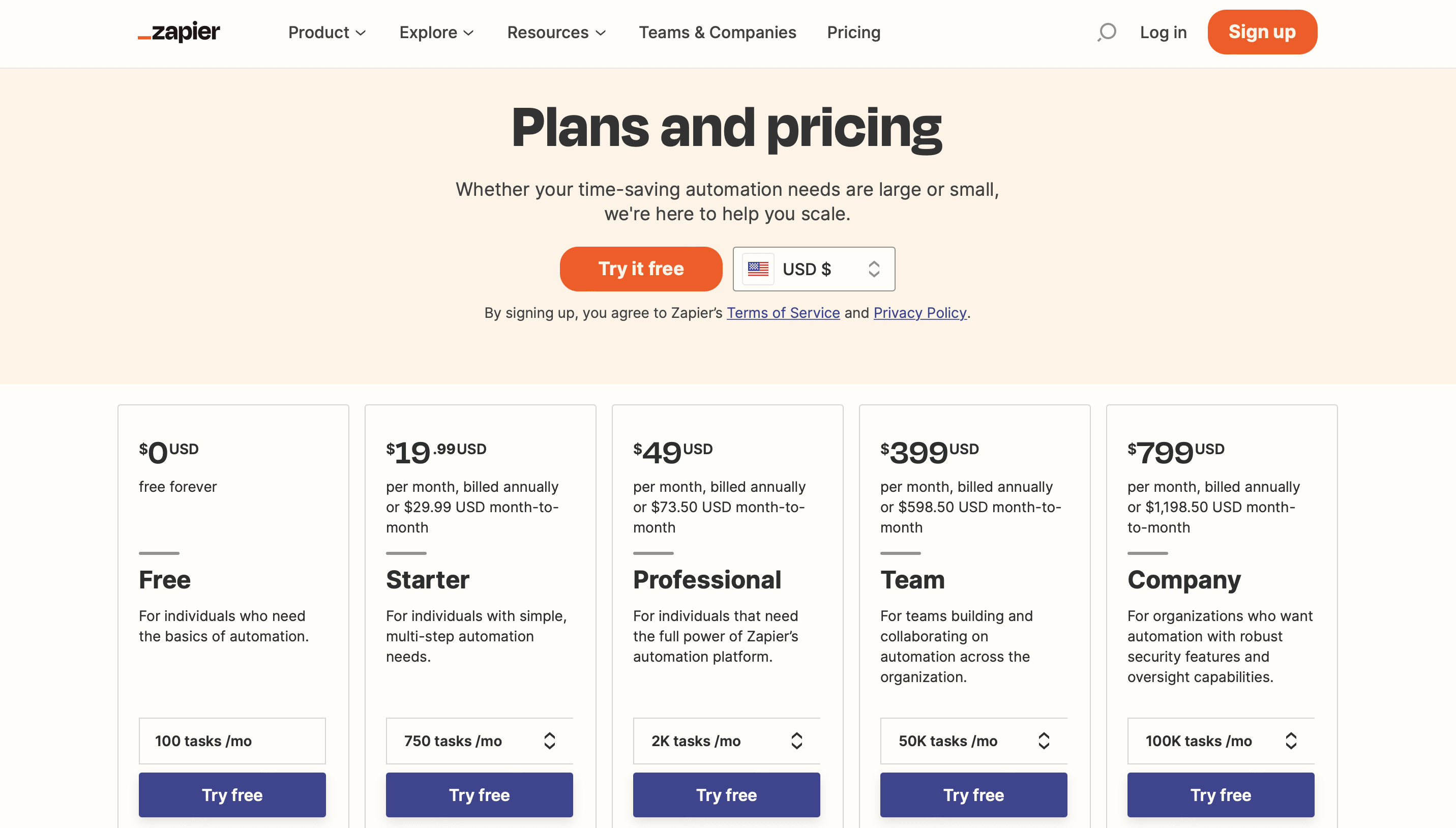
In summary, Kajabi is primarily focused on creating and selling digital products, while Zapier is an automation tool for connecting apps and automating tasks. The pricing and features of both platforms vary significantly based on their respective functionalities.
Frequently Asked Questions
Q: What is Kajabi?
A: Kajabi is an all-in-one platform designed for businesses, course creators, and online entrepreneurs to build, market, and sell their digital products or services. It includes tools for creating websites, landing pages, online courses, membership sites, and email marketing campaigns.
Q: What is Zapier?
A: Zapier is a web-based automation tool that allows users to integrate different applications and automate their workflows. It supports over 3,000 applications and enables users to build custom automations by using a simple, no-code interface.
Q: Does Kajabi offer integration with other applications?
A: Yes, Kajabi offers integration with a variety of third-party applications, including email marketing tools, payment gateways, and customer relationship management (CRM) systems. However, the number of integrations may be more limited compared to Zapier, which supports over 3,000 apps.
Q: Can I use Zapier to automate my Kajabi workflows?
A: Yes, you can use Zapier to connect Kajabi with other applications and automate tasks such as sending email notifications, creating contacts in CRM systems, or updating spreadsheets based on Kajabi actions.
Q: Which platform is more cost-effective, Kajabi or Zapier?
A: The cost-effectiveness of Kajabi and Zapier depends on your specific requirements and the features you need. Kajabi offers a complete solution for building, marketing, and selling digital products starting from $149 per month, while Zapier offers a range of pricing plans starting from a free tier to custom pricing for large-scale enterprises.
Q: Are Kajabi and Zapier suitable for beginners?
A: Both Kajabi and Zapier are user-friendly and cater to beginners. Kajabi offers a comprehensive platform to help users build and grow their businesses, even with limited technical knowledge. Zapier provides intuitive, no-code automation that can be easily set up by users with little to no programming experience.
Q: Is it possible to use both Kajabi and Zapier together?
A: Yes, it is possible to use both Kajabi and Zapier together. By integrating Kajabi with Zapier, users can enhance their Kajabi-powered business with the extensive automation capabilities offered by Zapier, creating a more streamlined and efficient workflow.
|
Featured Partner 
on Kajabi’s website
|
Conclusion
In conclusion, the Kajabi versus Zapier debate underlines the significance of understanding the unique needs and requirements of your business before choosing an automation and integration platform.
While both tools offer valuable features to streamline workflow processes and optimize productivity, they cater to different market segments and goals.
Kajabi, primarily designed for online course creators and digital entrepreneurs, offers user-friendly, all-in-one functionality that enables content hosting, website building, and marketing automation within a single ecosystem. This ultimately simplifies day-to-day tasks and allows businesses to focus on producing high-quality content.
On the other hand, Zapier significantly enhances the automation capabilities of myriad applications across a diverse range of industries. Its powerful integration abilities can connect to a vast repository of apps, making it the ideal choice for businesses that rely on multiple platforms and services for their operations.
Ultimately, the decision between Kajabi and Zapier boils down to the specific needs of your online business. If you’re an online course creator or digital entrepreneur looking for a unified and straightforward solution, Kajabi might be the better choice.
However, if your primary goal is to seamlessly integrate multiple applications for more extensive process automation, Zapier would undoubtedly be the more suitable option. By taking the time to comprehensively evaluate the advantages and limitations of each tool in light of your business goals, you can ensure that you’re making the most informed decision for your long-term success.

